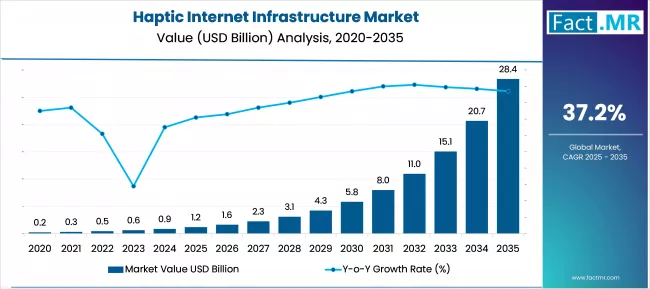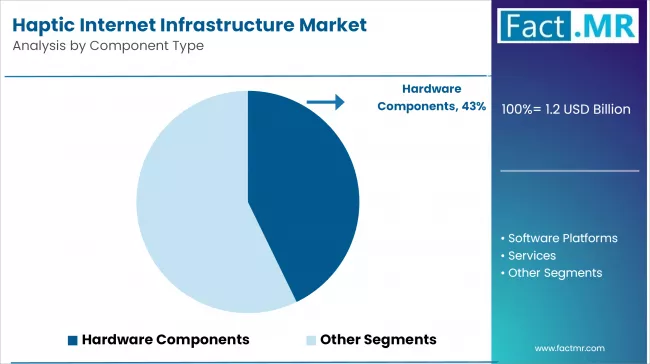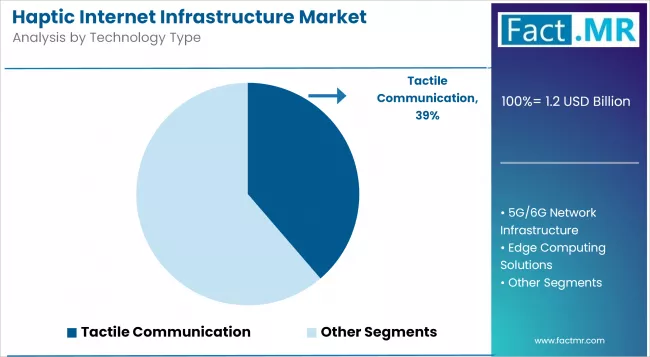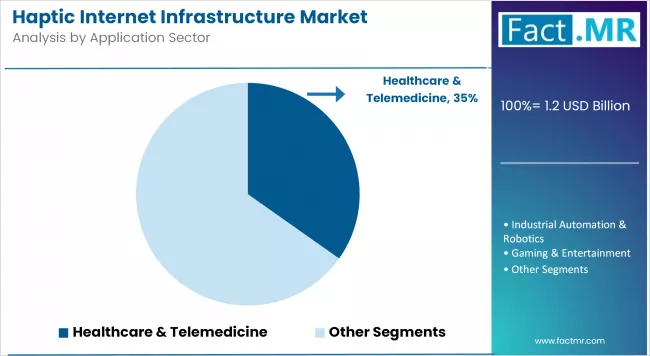Haptic Internet Infrastructure Market Forecast and Outlook 2025 to 2035
The global haptic internet infrastructure market is projected to grow from USD 1.2 billion in 2025 to approximately USD 28.4 billion by 2035, recording an absolute increase of USD 27.2 billion over the forecast period. This translates into a total growth of 2,266.7%, with the market forecast to expand at a compound annual growth rate (CAGR) of 37.2% between 2025 and 2035. The overall market size is expected to grow by more than 23.7X during the same period, supported by increasing demand for ultra-low latency communication systems, rising adoption of remote-control technologies, and growing emphasis on immersive tactile experiences across industries.
Quick Stats for Haptic Internet Infrastructure Market
Haptic Internet Infrastructure Market Value (2025): USD 1.2 billion
Haptic Internet Infrastructure Market Forecast Value (2035): USD 28.4 billion
Haptic Internet Infrastructure Market Forecast CAGR: 37.2%
Leading Component Type in Haptic Internet Infrastructure Market: Hardware Components (42.8%)
Key Growth Regions in Haptic Internet Infrastructure Market: Asia Pacific, North America, and Europe
Key Players in Haptic Internet Infrastructure Market: Ericsson AB, Nokia Corporation, Huawei Technologies Co. Ltd., Cisco Systems Inc., Microsoft Corporation, Amazon Web Services Inc., Intel Corporation, Qualcomm Incorporated, Samsung Electronics Co. Ltd.

Between 2025 and 2030, the haptic internet infrastructure market is projected to expand from USD 1.2 billion to USD 6.8 billion, resulting in a value increase of USD 5.6 billion, which represents 20.6% of the total forecast growth for the decade. This phase of growth will be shaped by accelerating 5G/6G network deployment, increasing integration of tactile communication in industrial applications, and growing demand for real-time haptic feedback in healthcare and gaming sectors. Technology companies are expanding their haptic internet infrastructure portfolios to address the growing demand for ultra-responsive, tactile-enabled communication systems across remote operation and immersive experience applications.
Haptic Internet Infrastructure Market Key Takeaways
Metric
Value
Estimated Value in (2025E)
USD 1.2 billion
Forecast Value in (2035F)
USD 28.4 billion
Forecast CAGR (2025 to 2035)
37.2%
From 2030 to 2035, the market is forecast to grow from USD 6.8 billion to USD 28.4 billion, adding another USD 21.6 billion, which constitutes 79.4% of the overall ten-year expansion. This period is expected to be characterized by widespread deployment of tactile internet applications, integration of advanced haptic feedback systems, and development of comprehensive ultra-low latency network infrastructure. The growing adoption of remote surgery capabilities and increasing enterprise demand for real-time tactile communication will drive demand for sophisticated haptic internet infrastructure with enhanced responsiveness and reliability characteristics.
Between 2020 and 2025, the haptic internet infrastructure market experienced explosive expansion from nascent technology development, driven by breakthrough advancements in ultra-low latency networking and growing recognition of tactile communication potential in critical applications. The market developed as technology providers recognized the transformative opportunity for remote tactile interaction, real-time haptic feedback, and comprehensive tactile internet ecosystem development. Research initiatives and prototype deployments began emphasizing the importance of haptic internet infrastructure in enabling revolutionary human-machine interaction and remote operation capabilities.
Why is the Haptic Internet Infrastructure Market Growing?
Market expansion is being supported by the increasing demand for ultra-low latency communication systems and corresponding need for real-time tactile feedback capabilities that can support critical remote operations and immersive experiences. Modern technology applications are increasingly focused on haptic internet infrastructure that can provide instantaneous tactile response, seamless remote-control capabilities, and comprehensive sensory feedback integration. The revolutionary potential of haptic internet technology in enabling breakthrough remote interaction capabilities and immersive tactile experiences makes it an essential component of next-generation communication infrastructure development.
The growing emphasis on Industry 4.0 and remote operation capabilities is driving demand for advanced tactile communication solutions that address specific real-time interaction requirements and support critical remote-control applications. Enterprise preferences for infrastructure solutions that combine ultra-low latency networking, advanced haptic feedback systems, and comprehensive tactile communication capabilities are creating opportunities for innovative platform development. The rising influence of 5G/6G network deployment and edge computing integration is also contributing to increased adoption of haptic internet infrastructure across different industrial applications and immersive technology sectors.
Segmental Analysis
The market is segmented by component type, technology type, application sector, deployment model, end-user profile, and region. By component type, the market is divided into hardware components, software platforms, and services.
Based on technology type, the market is categorized into tactile communication, force feedback systems, 5G/6G network infrastructure, and edge computing solutions. In terms of application sector, the market is segmented into healthcare & telemedicine, industrial automation & robotics, gaming & entertainment, and automotive.
For deployment models, the market is segmented into cloud-based infrastructure and hybrid cloud-edge solutions. By end-user profile, the market is segmented into enterprise customers and gaming companies & entertainment studios. Regionally, the market is divided into North America, Europe, Asia Pacific, Latin America, and Middle East & Africa.
By Component Type, Hardware Components Segment Accounts for 42.8% Market Share

The hardware components segment is projected to account for 43.0% of the haptic internet infrastructure market in 2025, reaffirming its position as the category’s dominant component type. Technology organizations increasingly recognize the fundamental importance of specialized hardware components for deploying haptic internet capabilities, particularly haptic actuators, tactile sensors, and network infrastructure that provide essential tactile feedback and ultra-low latency communication capabilities. This component type addresses both physical interaction requirements and network infrastructure needs, providing critical technological foundations for haptic internet implementations.
Within the hardware components segment, haptic actuators lead with 18.9% market share, followed by tactile sensors at 14.7% and network infrastructure at 9.4%. This component type forms the foundation of most haptic internet deployments, as it represents the most technologically advanced and operationally critical approach to tactile communication and remote interaction in emerging technology applications.
Hardware validation and performance testing continue to strengthen confidence in these specialized components. With increasing recognition of the precision requirements in haptic internet systems, hardware components align with both immediate deployment needs and long-term performance optimization objectives, making them the central growth driver of haptic internet infrastructure demand.
By Technology Type, Tactile Communication Segment Accounts for 39.0% Market Share

Tactile communication technology is projected to represent 39.0% of haptic internet infrastructure demand in 2025, underscoring its role as the primary enabling technology for haptic internet implementations.
Technology organizations recognize that tactile communication provides the essential ultra-low latency networking and real-time data processing capabilities that traditional communication systems cannot adequately support for critical haptic applications. Tactile communication offers enhanced operational responsiveness through instantaneous feedback transmission and real-time sensory data exchange capabilities.
Within the tactile communication segment, ultra-low latency networks lead with 21.4% market share, followed by real-time data processing at 17.6%. The segment is supported by the critical nature of instantaneous response requirements in haptic applications and the growing recognition that tactile communication technologies can optimize both interaction quality and operational reliability.
Additionally, enterprises are increasingly adopting communication technologies that can maintain sub-millisecond latency while delivering consistent tactile feedback quality. As haptic internet technology advances toward comprehensive sensory integration, tactile communication technologies will continue to play a crucial role in enabling real-time haptic interaction and remote operation capabilities.
By Application Sector, Healthcare & Telemedicine Segment Accounts for 35.0% Market Share

The healthcare & telemedicine application sector is forecasted to contribute 35.0% of the haptic internet infrastructure market in 2025, reflecting the critical importance of tactile feedback in medical applications and remote healthcare delivery.
Healthcare organizations rely on haptic internet infrastructure for the precision, reliability, and real-time responsiveness required for remote surgery, medical training, and rehabilitation applications, making them the cornerstone of haptic internet technology adoption. This application sector provides essential market validation including clinical precision requirements, safety standards compliance, and operational reliability validation.
Within the healthcare & telemedicine segment, remote surgery leads with 18.9% market share, followed by rehabilitation systems at 10.7% and medical training at 5.4%. The segment benefits from established relationships between healthcare institutions and medical technology providers, who offer comprehensive system integration and ongoing clinical support services. Healthcare applications also provide advantages in terms of regulatory validation, clinical testing environments, and feedback for technology optimization.
With growing emphasis on remote healthcare delivery and medical technology advancement, healthcare & telemedicine applications serve as critical drivers for haptic internet infrastructure development, making them fundamental contributors to market growth and technology validation.
By Deployment Model, Cloud-based Infrastructure Segment Accounts for 58.4% Market Share

Cloud-based infrastructure deployment is projected to represent 58.4% of haptic internet infrastructure demand in 2025, underscoring its role as the preferred deployment approach for scalable haptic internet implementations.
Technology organizations recognize that cloud-based deployments provide the computational power, network optimization, and global accessibility that traditional infrastructure cannot adequately support for comprehensive haptic internet operations. Cloud deployments offer enhanced scalability through distributed processing capabilities and optimized network routing for ultra-low latency requirements.
Within the cloud-based infrastructure segment, public cloud leads with 32.7% market share, followed by private cloud at 25.7%. The segment is supported by the demanding computational requirements of real-time haptic processing and the growing recognition that cloud infrastructures can optimize both performance scalability and cost-effectiveness.
Additionally, technology providers are increasingly adopting cloud deployment strategies that can scale globally while maintaining consistent ultra-low latency performance across diverse geographical locations. As haptic internet technology advances toward comprehensive global deployment, cloud-based infrastructure will continue to play a crucial role in enabling scalable haptic internet accessibility and performance optimization.
What are the Drivers, Restraints, and Key Trends of the Haptic Internet Infrastructure Market?
The haptic internet infrastructure market is advancing rapidly due to increasing demand for ultra-low latency communication and growing adoption of remote control technologies. However, the market faces challenges including complex network requirements, high infrastructure costs, and concerns about technology standardization across different application platforms. Innovation in edge computing integration and advanced tactile feedback systems continue to influence product development and market expansion patterns.
Expansion of 5G/6G Network Infrastructure and Ultra-Low Latency Technologies
The growing deployment of 5G and emerging 6G network technologies is enabling more sophisticated ultra-low latency communication capabilities and comprehensive tactile internet applications. Advanced network infrastructure with 5G/6G integration offers comprehensive connectivity optimization, including edge computing integration, network slicing capabilities, and ultra-reliable low-latency communication that are particularly important for critical haptic applications. Next-generation network infrastructure provides access to sub-millisecond response times and improved operational reliability through advanced network architectures.
Integration of Artificial Intelligence and Machine Learning for Haptic Optimization
Modern haptic internet infrastructure providers are incorporating artificial intelligence and machine learning technologies such as predictive haptic rendering, intelligent network optimization, and adaptive feedback systems to enhance tactile communication quality and system performance.
These technologies improve haptic response accuracy, enable proactive network optimization, and provide better integration with comprehensive haptic internet management systems. Advanced AI integration also enables personalized haptic experiences and improved operational cost optimization throughout the haptic internet ecosystem.
Analysis of Haptic Internet Infrastructure Market by Key Country

Country
CAGR (2025-2035)
China
44.8%
Japan
42.7%
South Korea
41.3%
Germany
39.6%
USA
37.2%
Singapore
35.8%
Finland
34.1%
The haptic internet infrastructure market is experiencing exceptional growth globally, with China leading at a 44.8% CAGR through 2035, driven by massive 5G/6G infrastructure investments, comprehensive industrial automation programs, and advanced technology research initiatives. Japan follows at 42.7%, supported by robotics technology leadership, healthcare innovation programs, and comprehensive tactile technology development capabilities. South Korea shows growth at 41.3%, emphasizing advanced telecommunications infrastructure and gaming technology leadership. Germany records 39.6% growth, focusing on industrial automation excellence and comprehensive manufacturing technology development. The USA demonstrates 37.2% growth, representing established technology innovation ecosystem and comprehensive enterprise technology adoption programs.
The report covers an in-depth analysis of 40+ countries; six top-performing countries are highlighted below.
China Demonstrates Growing Market Potential with Infrastructure Investment Leadership
Revenue from haptic internet infrastructure in China is projected to exhibit exceptional growth with a CAGR of 44.8% through 2035, driven by comprehensive telecommunications infrastructure investment programs and massive government support for next-generation communication technology development. The country’s extensive 5G deployment and growing emphasis on industrial automation are creating significant opportunities for haptic internet infrastructure adoption. Major international and domestic technology companies are establishing comprehensive development partnerships to serve the growing demand for ultra-low latency communication solutions across industrial and consumer applications.
Government initiatives supporting advanced telecommunications infrastructure and smart manufacturing development are driving demand for comprehensive haptic internet technologies throughout industrial facilities and technology development centers nationwide.
Infrastructure modernization programs and telecommunications advancement initiatives are supporting appropriate deployment of haptic internet technologies among manufacturers and technology companies across diverse applications.
Japan Demonstrates Exceptional Market Potential with Robotics Technology Leadership
Revenue from haptic internet infrastructure in Japan is expanding at a CAGR of 42.7%, supported by robotics technology excellence, advanced healthcare innovation capabilities, and comprehensive tactile technology research programs. The country’s leadership in precision manufacturing and increasing emphasis on remote operation technologies are driving demand for advanced haptic internet infrastructure solutions. International technology companies and domestic innovators are establishing development partnerships to serve the growing demand for sophisticated tactile communication and remote control systems.
Rising emphasis on robotics technology advancement and healthcare innovation are creating opportunities for sophisticated haptic internet infrastructure across industrial automation and medical technology applications.
Growing technology research programs and advanced manufacturing initiatives are supporting increased adoption of haptic internet technologies among organizations requiring ultra-precise remote operation and tactile feedback capabilities.
United States Maintains Market Leadership with Technology Innovation Excellence

Demand for haptic internet infrastructure in the USA is projected to grow at a CAGR of 37.2%, supported by comprehensive technology innovation ecosystem and established enterprise technology development programs. American technology enterprises consistently invest in cutting-edge communication infrastructure for competitive advantage and operational breakthrough. The market is characterized by mature research and development capabilities, comprehensive innovation infrastructure, and established relationships between technology providers and enterprise customers.
Technology innovation leadership and enterprise digital transformation initiatives are supporting continued adoption of advanced haptic internet infrastructure throughout industrial and healthcare applications.
Technology industry networks and research organizations are facilitating access to next-generation communication technologies while ensuring appropriate development and performance optimization.
South Korea Shows Promising Growth with Telecommunications Excellence
Revenue from haptic internet infrastructure in South Korea is projected to grow at a CAGR of 41.3% through 2035, driven by telecommunications infrastructure excellence, comprehensive gaming industry development, and growing emphasis on immersive technology applications. South Korean technology companies are increasingly adopting haptic internet technologies for competitive advantage and technological leadership, supported by expanding 5G infrastructure and improved integration with existing technology ecosystems.
Telecommunications infrastructure excellence and gaming industry leadership are supporting increased availability of haptic internet infrastructure across diverse entertainment and industrial applications.
Growing collaboration between international technology companies and domestic innovators is enhancing infrastructure options and technical expertise in haptic internet technology development and deployment.
Germany Demonstrates Stable Growth with Industrial Automation Leadership
Revenue from haptic internet infrastructure in Germany is projected to grow at a CAGR of 39.6% through 2035, supported by industrial automation leadership, advanced manufacturing technology development, and comprehensive Industry 4.0 implementation programs. German industrial enterprises consistently utilize advanced communication technologies as part of integrated manufacturing systems, emphasizing operational excellence and technological innovation.
Industrial automation leadership and advanced manufacturing programs are maintaining strong demand for haptic internet infrastructure across diverse industrial and manufacturing applications.
Technology development programs and manufacturing excellence initiatives are supporting continued innovation and appropriate utilization of advanced tactile communication solutions.
Singapore Demonstrates Stable Growth with Smart Nation Initiatives
Revenue from haptic internet infrastructure in Singapore is projected to grow at a CAGR of 35.8% through 2035, supported by comprehensive Smart Nation programs and advanced telecommunications infrastructure development that facilitates appropriate use of haptic internet technologies for diverse applications. Singaporean enterprises consistently utilize established advanced technologies for operational optimization, emphasizing innovation excellence and technological advancement within integrated smart city systems.
Smart Nation initiatives and telecommunications infrastructure excellence are supporting systematic adoption of advanced haptic internet infrastructure across urban and industrial applications.
Technology development programs and innovation excellence initiatives are maintaining high standards for haptic internet utilization and operational performance optimization.
Finland Anchors Growth with Telecommunications Technology Leadership
Revenue from haptic internet infrastructure in Finland is projected to grow at a CAGR of 34.1% through 2035, supported by the country’s telecommunications technology leadership, comprehensive 5G/6G research programs, and systematic approach to advanced communication technology development. Finnish technology companies emphasize cutting-edge communication solutions and next-generation network applications within structured innovation frameworks that prioritize technological excellence and operational reliability.
Telecommunications technology leadership and advanced network research are supporting stable development of haptic internet infrastructure across diverse technology-intensive applications.
Technology research institutions and innovation partnerships are maintaining leadership in haptic internet infrastructure development and deployment excellence for optimal communication performance outcomes.
Europe Market Split by Country
The haptic internet infrastructure market in Europe is projected to expand rapidly through 2035, supported by increasing emphasis on advanced telecommunications development, rising investment in Industry 4.0 technologies, and ongoing innovation in ultra-low latency communication systems. Germany will continue to lead the regional market, accounting for 32.4% in 2025 and rising to 34.7% by 2035, supported by industrial automation leadership, comprehensive manufacturing technology development, and robust telecommunications infrastructure capabilities. The United Kingdom follows with 18.9% in 2025, declining to 17.8% by 2035, driven by established technology companies, advanced research institutions, and growing emphasis on immersive technology development.
France holds 16.7% in 2025, increasing to 17.2% by 2035 as technology enterprises expand haptic internet infrastructure adoption and demand grows for advanced tactile communication solutions. Finland contributes 12.3% in 2025, growing to 13.9% by 2035, supported by telecommunications technology leadership and increasing advanced communication research capabilities. Sweden represents 9.8% in 2025, adjusting to 8.6% by 2035, underpinned by technology innovation infrastructure and growing telecommunications development programs.
Netherlands accounts for 6.2% in 2025, decreasing to 5.4% by 2035, supported by advanced technology ecosystem and innovation infrastructure development. BENELUX markets (excluding Netherlands) together represent 3.4% in 2025, declining to 2.1% by 2035, with demand influenced by regional technology development and telecommunications advancement patterns. The Rest of Western Europe moderates from 0.3% in 2025 to 0.3% by 2035, as larger core markets capture greater share of haptic internet technology investment and infrastructure development.
Japan Segmental Share by Country
The haptic internet infrastructure market in Japan is set to remain concentrated in industrial and robotics applications in 2025, reflecting national technological priorities and innovation leadership strategies. Industrial Automation & Robotics dominates with a 42.8% share in 2025, supported by Japan’s robotics technology excellence, comprehensive industrial automation programs, and growing emphasis on precision remote control and tactile feedback technologies.
Healthcare & Telemedicine represents 28.7% in 2025, maintaining significant presence due to Japan’s advanced healthcare technology development, aging population demographics, and increasing emphasis on remote medical applications and rehabilitation technologies. Gaming & Entertainment holds 19.6%, sustained by advanced gaming industry capabilities, immersive technology development, and increasing adoption of tactile gaming experiences.
The remaining 8.9% is attributed to other applications, reflecting the growing role of specialized technology requirements and emerging haptic internet applications entering Japanese technology and industrial market segments.
South Korea Segmental Share by Country
The haptic internet infrastructure market in South Korea in 2025 is shaped by strong emphasis on entertainment technology leadership and advanced industrial capabilities, reflecting both technological priorities and comprehensive innovation development objectives. Gaming & Entertainment accounts for the largest share at 38.4%, supported by South Korea’s gaming industry leadership, advanced entertainment technology development, and increasing emphasis on immersive and tactile gaming experiences.
Industrial Automation follows with 31.2%, driven by advanced manufacturing technology adoption, comprehensive automation programs, and growing emphasis on precision industrial control and remote operation capabilities. Healthcare Applications contributes 21.7%, supported by healthcare technology development, medical innovation programs, and increasing demand for advanced medical training and remote healthcare delivery systems.
The remaining 8.7% is attributed to other applications, including specialized technology requirements, research and development programs, and emerging haptic internet categories, highlighting opportunities for advanced tactile communication applications and expanded technological capabilities across diverse technology and industrial sectors.
Competitive Landscape of Haptic Internet Infrastructure Market
The haptic internet infrastructure market is characterized by competition among established telecommunications equipment manufacturers, advanced technology companies, and innovative communication solution providers. Companies are investing in advanced network technology development, ultra-low latency optimization, strategic partnerships, and comprehensive solution delivery to provide reliable, responsive, and scalable haptic internet infrastructure solutions. Technology development, network optimization, and enterprise deployment strategies are central to strengthening infrastructure portfolios and market leadership positioning.
Ericsson AB leads the market with 16.8% global value share, offering comprehensive telecommunications infrastructure and haptic internet solutions with a focus on ultra-low latency network optimization and enterprise integration capabilities. Nokia Corporation provides extensive network infrastructure and haptic communication technologies with emphasis on 5G/6G integration and operational reliability. Huawei Technologies Co. Ltd. focuses on advanced telecommunications equipment and comprehensive network solutions for haptic internet applications. Cisco Systems Inc. delivers specialized networking infrastructure with strong emphasis on ultra-low latency optimization and enterprise connectivity solutions.
Microsoft Corporation operates with focus on cloud-based haptic internet platforms and comprehensive enterprise solutions integration. Amazon Web Services Inc. provides extensive cloud infrastructure and edge computing capabilities for scalable haptic internet deployments. Intel Corporation specializes in advanced processing technologies and hardware optimization for haptic internet applications. Qualcomm Incorporated and Samsung Electronics Co. Ltd. provide comprehensive technology solutions to enhance market technological diversity and serve various industrial, healthcare, and entertainment applications across different operational requirements and haptic internet deployment scenarios.
Key Players in the Haptic Internet Infrastructure Market
Ericsson AB
Nokia Corporation
Huawei Technologies Co. Ltd.
Cisco Systems Inc.
Microsoft Corporation
Amazon Web Services Inc.
Intel Corporation
Qualcomm Incorporated
Samsung Electronics Co. Ltd.
Scope of the Report
Items
Values
Quantitative Units (2025)
USD 1.2 Billion
Component Type
Hardware Components, Software Platforms, Services
Technology Type
Tactile Communication, Force Feedback Systems, 5G/6G Network Infrastructure, Edge Computing Solutions
Application Sector
Healthcare & Telemedicine, Industrial Automation & Robotics, Gaming & Entertainment, Automotive
Deployment Model
Cloud-based Infrastructure, Hybrid Cloud-Edge Solutions
End-User Profile
Enterprise Customers, Gaming Companies & Entertainment Studios
Regions Covered
North America, Europe, Asia Pacific, Latin America, Middle East & Africa
Countries Covered
United States, China, Japan, South Korea, Germany, United Kingdom, France, Finland, Singapore, India, Brazil and 40+ countries
Key Companies Profiled
Ericsson AB, Nokia Corporation, Huawei Technologies Co. Ltd., Cisco Systems Inc., Microsoft Corporation, Amazon Web Services Inc., Intel Corporation, Qualcomm Incorporated, Samsung Electronics Co. Ltd.
Additional Attributes
Dollar sales by component type and application category, regional technology adoption trends, competitive landscape, enterprise preferences for specific haptic internet solutions, integration with 5G/6G infrastructure development, innovations in ultra-low latency technologies, performance optimization, and tactile communication advancement
Haptic Internet Infrastructure Market by Segments
Component Type :
Hardware Components
Haptic Actuators
Tactile Sensors
Network Infrastructure
Software Platforms
Haptic Rendering Software
Network Management
Services
Integration Services
Maintenance & Support
Technology Type :
Tactile Communication
Ultra-Low Latency Networks
Real-time Data Processing
Force Feedback Systems
Kinesthetic Feedback
Tactile Feedback
5G/6G Network Infrastructure
Edge Computing Solutions
Application Sector :
Healthcare & Telemedicine
Remote Surgery
Rehabilitation Systems
Medical Training
Industrial Automation & Robotics
Remote Control Systems
Quality Control
Maintenance Operations
Gaming & Entertainment
VR/AR Applications
Immersive Gaming
Automotive
Deployment Model :
Cloud-based Infrastructure
Public Cloud
Private Cloud
Hybrid Cloud-Edge Solutions
Edge Computing
Hybrid Architecture
End-User Profile :
Enterprise Customers
Healthcare Institutions
Manufacturing Companies
Research Organizations
Gaming Companies & Entertainment Studios
Region :
North America
United States
Canada
Mexico
Europe
Germany
United Kingdom
France
Finland
Sweden
Netherlands
BENELUX (excl. Netherlands)
Rest of Western Europe
Asia Pacific
China
Japan
South Korea
Singapore
India
Australia
Rest of Asia Pacific
Latin America
Brazil
Argentina
Rest of Latin America
Middle East & Africa
GCC Countries
South Africa
Rest of Middle East & Africa
